









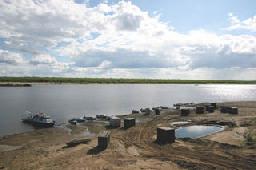 The settlement of Staroturukhansk (Old Turukhansk; translator’s note) became
the last place of refuge for the participants of our expedition along the river
Turukhan. Terribly tired, but happy, we returned to Turukhansk, where the
advantages of civilization wre already waiting for us: a bath house, clean
bedding and salvation from the mosquito plague.
The settlement of Staroturukhansk (Old Turukhansk; translator’s note) became
the last place of refuge for the participants of our expedition along the river
Turukhan. Terribly tired, but happy, we returned to Turukhansk, where the
advantages of civilization wre already waiting for us: a bath house, clean
bedding and salvation from the mosquito plague.
In actual fact, today’s Turukhansk is nothing but the former locality of Monastyrskoe. The Turukhansk winter road was built in 1607 – 27 verst away from Yeniseysk, on the bank of the Nikolsk sidearm of the Turukhan river. The road was constructed by the two wojewods – Dawyd Sherebtsov and Kurdyuk Davydov. Nothing has been left from the former settlement, which was buried in oblivion for several centuries and, apart from this, was destroyed by fire. Nothing has been left even from the Church of Nikolai, the thaumaturg. Nevertheless, we, the journalists, were aware of the fact that we were walking on very old, holy ground. The ground of the New Mangasea – boiling with gold……
Old Mangasea, the first Russian town in Siberia, was founded and built 200 kms south of the mouth of the Tas Bay - on the order of Boris Godunov; however, its geographical position turned out to be unfavourable with regard to the delivery of freights.
A drawing from the year 1701 shows Novaya Mangasea twice as big as the original place. The new town was surrounded by battlements of 6 meters in height; it disposed of five watch towers, one of which had quite unusual architectonic features and rose 25 meters up to the sky.
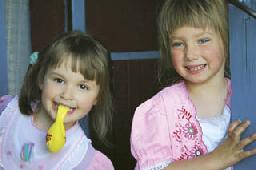 In the 18th century agriculture and trade were prospering in Turukhansk (Novaya
Mangasea or Old Turukhansk). Big market events were organized every year. The
prices for foodstuffs were as follows: mamoth bones (per pud) – 1,5 rubels,
bread (per pud) – 1,5 arctic fox skins, a bar of tea – 2 arctic fox skins, one
pound of makhorka – 1 arctic fox skin, one pound of rye or wheat rusk – 2 arctic
fox paws or 2 tails.
In the 18th century agriculture and trade were prospering in Turukhansk (Novaya
Mangasea or Old Turukhansk). Big market events were organized every year. The
prices for foodstuffs were as follows: mamoth bones (per pud) – 1,5 rubels,
bread (per pud) – 1,5 arctic fox skins, a bar of tea – 2 arctic fox skins, one
pound of makhorka – 1 arctic fox skin, one pound of rye or wheat rusk – 2 arctic
fox paws or 2 tails.
The exiled dekabrists, N. Bobrishchev-Pushkin, F. Shakhovskoi (a remote descendant of Mangaseia’s founder – Miron Shakhovskoi), S. Avramov, N. Listovskiy and S. Krivtsov, lived in Turukhansk between 1826 and 1828; they have been kept in good memory for a long time. It was Fedor Shakhovskiy who, for example, who taught the inhabitants of Turukhansk all basic knowledge about market gardening. It was he, who, with a knowing hand, cultivated the first potatoes in this place.
Thus, it is not really surprising that the only road in today’s Staroturukhansk (Old Turukhansk) is called “Street of the Decabrists”. By the way, it is unbelievably curvaceous and the houses along the roadside are standing all in a tumble, some closely together, as if concentrated in one place, others all scattered amidst the scenery.
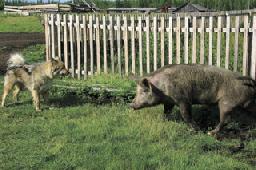 We were unable to find the building of the Staroturukhansk village counsil.
Instead, we were immediately shown the house of the chairman. Whenever Nikolai
Nikolaevich Makhenko is looking out of the window, he has a nice view of the
square where the dances take place, the little shops and the carousel, which was
constructed from parts of a potatoe harvester. The chairman tries his best to
keep up with what the young people of the village are doing, to always be well
informed about everything, although everything is known to him, anyway, for he
is the musical director of all local events of mass culture. The first thing he
started to do was telling us, the journalists from Krasnoyarsk, about the great
number of all-round talents growing up in this area!
We were unable to find the building of the Staroturukhansk village counsil.
Instead, we were immediately shown the house of the chairman. Whenever Nikolai
Nikolaevich Makhenko is looking out of the window, he has a nice view of the
square where the dances take place, the little shops and the carousel, which was
constructed from parts of a potatoe harvester. The chairman tries his best to
keep up with what the young people of the village are doing, to always be well
informed about everything, although everything is known to him, anyway, for he
is the musical director of all local events of mass culture. The first thing he
started to do was telling us, the journalists from Krasnoyarsk, about the great
number of all-round talents growing up in this area!
However, Nikolai Nikolaevich did not spend a lot of time to boast of the successful development of his own child. Instead, we learned from Marina Makhenko of all people, who had won the district competition with her seminar papers and, as a steepening incentive, received a voucher for a trip to Anapa, about the glorious history of the village.
In winter, the inhabitants of Staroturukhansk can only reach the regional town across the ice by using their “Buran” (snow mobile; translator’s note). As long as the rivers are still freezing up, they usually take the helicopter and in summer by motot boat across the Yenisey and Turukhan rivers. By the way, the locals have an explanation for why the river is named Turukhan.
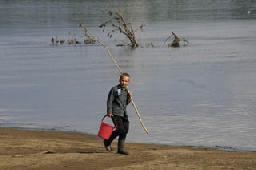 Apart from this, we learned everything about shamans. In these places every
shaman disposes of his own “shesl” (wand; translator’s note) or “posokh” (stick;
translator’s note), on which a shaman tree (world tree, tree of life;
translator’s note) is depicted. This “shesl” was called “turu”. In case a shaman
did not dispose of much strength, the stick he was using was of small size
accordingly – in this case it would bear the name of a “turukan”. And this is
where the name of the river is said to originate from. By the time the first
Russian settlers arrived in this place, the people living here would already use
the word “Turukhan” instead of “turukan”.
Apart from this, we learned everything about shamans. In these places every
shaman disposes of his own “shesl” (wand; translator’s note) or “posokh” (stick;
translator’s note), on which a shaman tree (world tree, tree of life;
translator’s note) is depicted. This “shesl” was called “turu”. In case a shaman
did not dispose of much strength, the stick he was using was of small size
accordingly – in this case it would bear the name of a “turukan”. And this is
where the name of the river is said to originate from. By the time the first
Russian settlers arrived in this place, the people living here would already use
the word “Turukhan” instead of “turukan”.
Nowadays, 121 people live in Staroturukhansk. Most of them are engaged in hunting, fishing and collecting wild plants. And they have 43 heads of horned cattle. They bottle the milk and send it to the district center, where it is made available for kindergartens, schools and boarding schools. Staroturukhansk is ranging among the leading locations of stock-breeding within the district. During the summer vacation the little Selkupes from Maduika recover so well that their educators hardly recognize them when they return home. Having regained all their strength, they begin to sind and dance and recite poems.
Nature is unique in this place. While Maduika is situated in the permafrost zone, the roses are in full flower and the water melons are mellowing in Staroturukhansk. Just enter any house and you will hear the landlord boasting his big, beautiful vegetable garden in the summer, and his wide range of canned, pickled and salted foodstuffs.
The people here are always diligent and have a powerful build. People seldom address themselves to Nina Borisovna Pokalo’s sanitary and midwife’s station, which reminds you of an operating room because of its meticulous cleanness. Although we can derive from archival documents that Novaya Mangazeya was founded in a boring, remote and unhealthy place. The local residents had to permanently cope with dirty-brown mud, which would not even completely dry up in scorching heat. The tundra was all steaming and the sky filled with all kinds of harmful damp, which caused the break-out of diseases.
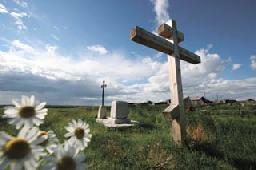 Nikolai Nikolaevich Makhenko recalls that, in former times, the situation was
all the same, that he used to go about in rubber boots during the summer. And
now he is trudging through the mud with slippers, accompanying us to the cutter
– well, never mind! He did not perish by drowning, after all.
Nikolai Nikolaevich Makhenko recalls that, in former times, the situation was
all the same, that he used to go about in rubber boots during the summer. And
now he is trudging through the mud with slippers, accompanying us to the cutter
– well, never mind! He did not perish by drowning, after all.
It seemed as if an evil spell was casted on us! When we had almost reached the embankment, it started raining cats and dogs. How improvidently our friend had pushed his rubber boots into the sternmost corner!
We headed for Turukhansk, leaving behind all those track sections of Stalin’s railroad connecting Yanov Stan, Verkhnaya Baikha (were we arrived at the crack of down and decided not to disturb the local residents), Farkovo and, finally, Staroturukhansk. People say: the north is and will remain the north: with its invariable colours, faces and problems. But this is not true! The north is so many-sided, so multifaceted that, every time you come to visit there again, you will discover new interesting things.
Tatiana Makogonova
Photos: Aleksander Kuznetsov, Vladimir PAVLOVSKIY
“Krasnoyarsk Labourer”, 27.08.2005